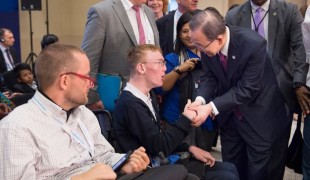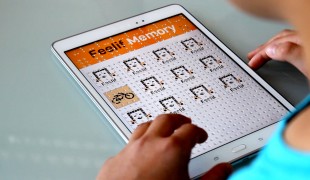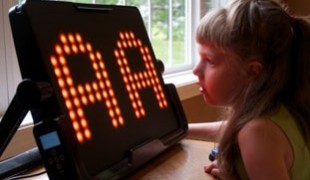- 4258
- 372
- 2
- 2
- 0
- Help Ukraine
About the solution
Logan was in a coma for nearly 12 days when he was 13 years old, as a result of a rare allergic reaction he had to some contrast agents from a routine MRI. After waking up from the coma, he couldn’t walk, he had lost several motor skills, was speech impaired and almost completely blind. But is mind was fully working.
Before his first college year, Logan met Ann Gully, a science, technology, engineering, and math (STEM) tutoring coordinator at Auburn University at Montgomery (AUM). She tried to help him by making sandpaper cutouts of numbers and symbols. Most blind students use the Nemeth Code (a version of Braille for math that codes for everything from fractions to trigonometric functions) but this wasn’t a good option for Logan due to his mobility limitations. So Ann and Logan decided to create their own system.
With the help of Jordan Price, an undergraduate studying ecological population models who worked as a math tutor, the team developed a process of trial and error: Jordan would describe the “landscape” of an algebra problem, laying out the main objective. He would then break it down into auditory “chunks,” each of which was a definition, a value, or some other factor related to the problem. This worked, and Logan was able to understand the equations and problems - he even got A in algebra class.
In 2015, the Logan Project was born. “We focused on developing a methodology that would allow Logan to fully drive the intellectual processes involved in simplifying and solving algebraic expressions and equations. Our approach had to be unique because Logan's limited mobility will not allow him to use Nemeth Code, the math equivalent of Braille”, it says on the official website.
Currently, the team members use a method of audio communication to teach students one-on-one. In the future, they hope to create software that automates the process, making the method available to many.
The team got funding from AUM and from foundations.
Now they hope to expand the project and use the feedback from people to improve their system.
“From 2017 – 2019, the focus of our work is to expand the reach of Process-Driven Math and further build the body of evidence that it is an effective method of instruction and assessment for all learners, especially learners with visual and print disabilities. Education and accessibility specialists from AUM, Bridge Multimedia, and Eye on Access will join us in our effort to improve the tools for success in mathematics that are available to students with disabilities. Our goal is the creation of software with a Universal Design for Learning that will allow students who are blind or have low vision, as well as other diverse learners, to learn together with their sighted peers in an inclusive educational setting”, the official website states.
More info: http://www.aum.edu/logan-project
https://loganprickett.wordpress.com/
Adapted from: https://bit.ly/2FOlI57
https://www.youtube.com/watch?v=YM2gHXZa524
This solution shall not include mention to the use of drugs, chemicals or biologicals (including food); invasive devices; offensive, commercial or inherently dangerous content. This solution was not medically validated. Proceed with caution! If you have any doubts, please consult with a health professional.
DISCLAIMER: This story was written by someone who is not the author of the solution, therefore please be advised that, although it was written with the utmost respect for the innovation and the innovator, there can be some incorrect statements. If you find any errors please contact the patient Innovation team via info@patient-innovation.com
-
-
516
-
0
-
7145

Patient develops communication device
COMMUNICATION: Communicating, whether by speaking, listening, or other means
Reading
Cerebral Palsy
Neuromuscular Disorders
App (Including when connected with wearable)
Muscle cramps or spasms
Difficulty coordinating movements
Stiffness or rigidity (difficulty moving)
Paralysis of the legs and lower body
Muscle weakness
Difficulty speaking or understanding speech
Promoting self-management
Managing Neurological Disorders
Promoting inclusivity and social integration
Improving Speech and Communication
Neurology
Pediatrics
Russian Federation
-
-
-
761
-
2
-
12886

Feelif is a multimedia device for blind and visually impaired people
COMMUNICATION: Communicating, whether by speaking, listening, or other means
Reading
Video gaming
Blindness
Visual Impairment
Congenital Deafness
Hearing Disorders
App (Including when connected with wearable)
Videogame
Educational/Leisure device (book, toy, game...)
Vision problems
Hearing loss or ringing in the ears (tinnitus)
Managing Neurological Disorders
Improving Speech and Communication
General and Family Medicine
Medical Genetics
Neurology
Ophthalmology
Otorhinolaryngology
Pediatrics
Slovenia
-
-
-
570
-
0
-
8481

Mother invents device to help hearing and visually impaired daughter
COMMUNICATION: Communicating, whether by speaking, listening, or other means
Reading
Studying
Blindness
Educational/Leisure device (book, toy, game...)
App (Including when connected with wearable)
Vision problems
Regaining sensory function
Promoting self-management
Improving Speech and Communication
Caregiving Support
Ophthalmology
United States
-
 en
en